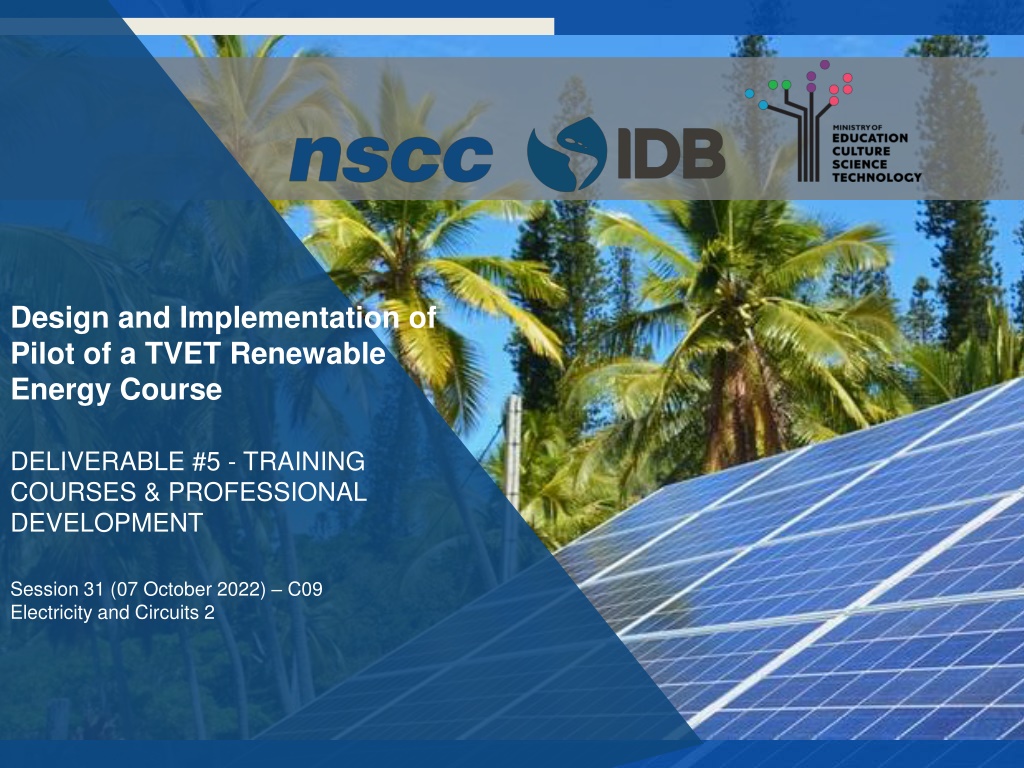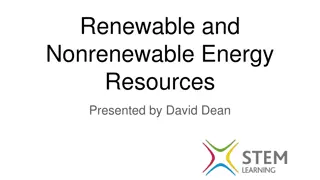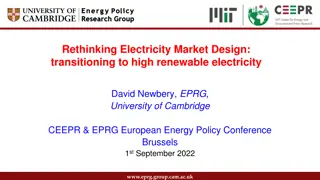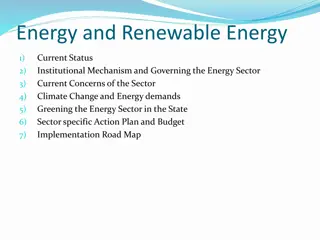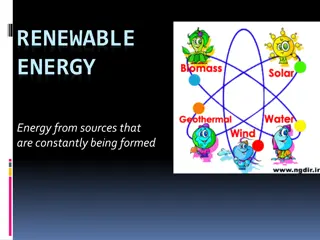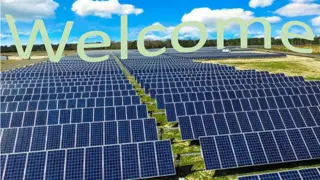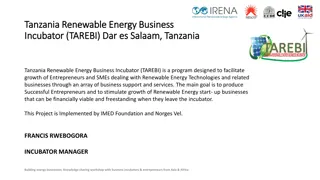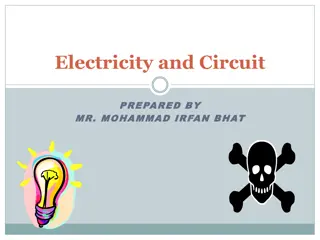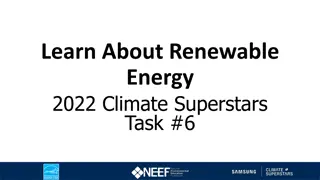Understanding Electricity and Circuits in Renewable Energy Systems
Explore the concepts of electricity and circuits in renewable energy systems, focusing on batteries, series and parallel connections, types of batteries, magnetism, motors, generators, and the operation of the electric grid. Anticipated outcomes include reviewing wire and cable sizes, identifying battery types and connections to PV panels, and demonstrating the transfer of current from PV panels to alternate current in a home setting.
Download Presentation

Please find below an Image/Link to download the presentation.
The content on the website is provided AS IS for your information and personal use only. It may not be sold, licensed, or shared on other websites without obtaining consent from the author. Download presentation by click this link. If you encounter any issues during the download, it is possible that the publisher has removed the file from their server.
E N D
Presentation Transcript
Design and Implementation of Pilot of a TVET Renewable Energy Course DELIVERABLE #5 - TRAINING COURSES & PROFESSIONAL DEVELOPMENT Session 31 (07 October 2022) C09 Electricity and Circuits 2
Topics Understand the battery as a source of electricity. Understand series and parallel connections for batteries. Describe the different types of batteries used in RE systems. Understand magnetism, motors and generators. Understand how the electric grid operates related to small RE systems
2. Term 2 Course Introductions C 09: Electricity and Circuits 2 Elec. Cir. 2 (in Calendar Table) Introduce the battery as a resource of stored electricity Series & parallel connections for batteries & PV panels List the types of batteries Understand magnetism, motors and generators Introduce alternating current (AC), voltage, and power Understand types of wire and cable
2. Term 2 Course Introductions C 09: Electricity and Circuits 2 Examples of anticipated outcomes after course completion Review & identify, existing & potential, wire & cable sizes Review & identify from drawings and at a customer s house, the battery type(s) with connections to PV panels Demonstrate understanding of how direct current from a PV panel source can become alternate current in a home Plan and use portable generators at customer s home
2. Term 2 Course Introductions C 09: Electricity and Circuits 2 Instructor Comments? Instructor Discussion? Instructor Suggestions? Real World Applications?
Relevancy Understanding the impact of electrical To promote an engineering mindset
Terminology Cycle a complete discharge and recharge of the battery Cycle life the quantity of cycles the battery can endure Capacity amount of energy stored measured in Watt-hours Specific gravity ratio of density to a reference material
Terminology Self-discharge - how much the battery discharges without load Gassing when charging is faster than absorption, which produces heat Thermal runaway When a battery charges too fast and generates excess heat Sulfation excess buildup of lead sulfate to plates Equalization A process to decrease sulfation on plates
Terminology Peak load the power required to start the load Average load the power it takes to keep a load running Duty Cycle also called depth of discharge Inverter converts DC to AC
What is a Battery? An electrochemical energy storage Converts chemical energy to electrical energy Has a positive and negative terminal
Parts of a battery This Photo by Unknown Author is licensed under CC BY
Types of Batteries Lead acid Flooded Sealed Lithium Lithium-ion Lithium-Iron-Phosphate
Flooded Lead Acid Wet cell Cheap Requires ventilation Low depth of discharge (DoD) @ 50% Upright storage Low cycle life Requires regular maintenance
Absorbent Glass Mat (AGM) More expensive the lead acid Cheaper than lithium Capable of 80% DOD Maintenance free Low cycle life
Lithium-Ion Requires little maintenance Expensive Higher energy density (150-200 Wh/kg High depth of discharge Little thermal protection
Lithium Iron Phosphate (LiFePO4) Requires little maintenance Expensive High energy density (90-120 Wh/kg) High depth of discharge Safer from thermal runaway
Connections Series Parallel Series-parallel
Rooftop Trainer To Lab High Voltage Trainer Trenched conduit AC Disconnect 240 VAC < 10 amp inverter PV 1: 60 cell 250 350 W PV 2 inverter PV 3 inverter PV 4 inverter PV 5 inverter PV 6 inverter Terminator
Rooftop Trainer To Lab High Voltage Trainer Trenched conduit DC Disconnect/ Combiner 150 DC Circuit Breakers PV 1: 60 cell 250 350 W PV 2 PV 3 PV 4 PV 5 PV 6
Induced Voltage X Voltage is induced when conductors cut lines of flux. Green arrow shows direction of conductor movement. Dot and X show direction of current caused by voltage. No voltage is induced when conductors move parallel to the to the lines of flux.
Power Generation A hydroelectric turbine converts the kinetic energy to electricity
Delta Connections Line 1 Line 2 Phase 3 Line 3 Delta-Connected Load Each load resistor will be connected to one of the phases. Delta-Connected Source The sum of the instantaneous phase voltages equals zero. For the delta-to-delta connection, Vline = Vphase = Vload. For the delta-to-delta connection, Iline = 1.732 Iphase = 1.732 Iload.
Wye Connections Line 1 Line 2 Line 3 Wye-Connected Source For the wye-to-wye connection with a balanced load: Wye-Connected Load Iline = Iphase = Iload. Vline = 1.732 Vphase = 1.732 Vload. There is no voltage between the source and load star-points.
Electric Motor Like a generator Uses electricity to provide drive load
